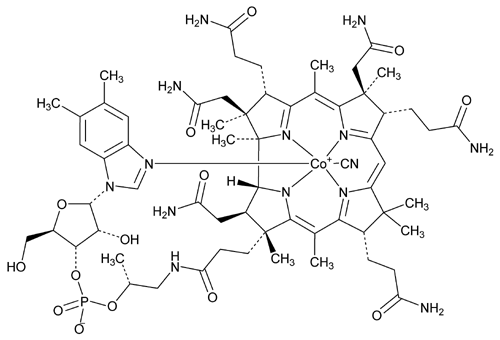Cyanocobalamin
» Cyanocobalamin contains not less than 96.0 percent and not more than 100.5 percent of C63H88CoN14O14P, calculated on the dried basis.
Packaging and storage—
Preserve in tight, light-resistant containers, and store at controlled room temperature.
Identification—
A:
The absorption spectrum of the solution employed for measurement of absorbance in the Assay exhibits maxima within ±1 nm at 278 nm and 361 nm and within ±2 nm at 550 nm. The ratio A361/A278 is between 1.70 and 1.90, and the ratio A361/A550 is between 3.15 and 3.40.
B:
Fuse about 1 mg with about 50 mg of potassium pyrosulfate in a porcelain crucible. Cool, break up the mass with a glass rod, add 3 mL of water, and dissolve by boiling. Add 1 drop of phenolphthalein TS, and add sodium hydroxide solution (1 in 10), dropwise, until just pink. Add 500 mg of sodium acetate, 0.5 mL of 1 N acetic acid, and 0.5 mL of nitroso R salt solution (1 in 500): a red or orange-red color appears at once. Add 0.5 mL of hydrochloric acid, and boil for 1 minute: the red color persists.
C:
Dissolve about 5 mg in 5 mL of water in a 50-mL distilling flask connected with a short, water-cooled condenser. To the flask add 2.5 mL of hypophosphorous acid, close, boil gently but short of distillation for 10 minutes, then distill 1 mL into a test tube containing 1 mL of sodium hydroxide solution (1 in 50). To the test tube add 4 drops of cold saturated ferrous ammonium sulfate solution, shake gently, then add about 30 mg of sodium fluoride, and bring the contents to a boil. Immediately add, dropwise, 5 N sulfuric acid until a clear solution results, then add 3 to 5 drops more of the acid: a blue or blue-green color develops within a few minutes.
Loss on drying  731
731 —
Heat about 25 mg, accurately weighed, in a suitable vacuum drying apparatus at 105
—
Heat about 25 mg, accurately weighed, in a suitable vacuum drying apparatus at 105 and at a pressure of not more than 5 mm of mercury for 2 hours, cool, and weigh: it loses not more than 12.0% of its weight.
and at a pressure of not more than 5 mm of mercury for 2 hours, cool, and weigh: it loses not more than 12.0% of its weight.
Pseudo cyanocobalamin—
Dissolve 1.0 mg in 20 mL of water contained in a small separator, add 5 mL of a mixture of equal volumes of carbon tetrachloride and m-cresol, and shake well for about 1 minute. Allow to separate, draw off the lower layer into a second small separator, add 5 mL of 5 N sulfuric acid, shake well, and allow to separate completely (the complete separation of the layer may be facilitated by centrifuging): the separated upper layer is colorless or has no more color than a mixture of 0.15 mL of 0.10 N potassium permanganate and 250 mL of water.
Assay—
Transfer about 30 mg of Cyanocobalamin, accurately weighed, with the aid of water to a 1-L volumetric flask, dilute with water to volume, and mix. Dissolve an accurately weighed quantity of USP Cyanocobalamin RS in water, and dilute quantitatively and stepwise with water to obtain a Standard solution having a known concentration of about 30 µg per mL. Concomitantly determine the absorbances of both solutions in 1-cm cells at the wavelength of maximum absorbance at about 361 nm, with a suitable spectrophotometer, using water as the blank. Calculate the quantity, in mg, of C63H88CoN14O14P in the Cyanocobalamin taken by the formula:
C(AU / AS)
in which C is the concentration, in µg per mL, of USP Cyanocobalamin RS in the Standard solution; and AU and AS are the absorbances of the solution of Cyanocobalamin and the Standard solution, respectively.
Auxiliary Information—
Please check for your question in the FAQs before contacting USP.
| Topic/Question | Contact | Expert Committee |
| Monograph | Curtis Phinney
1-301-816-8540 |
(DSN05) Dietary Supplements - Non-Botanicals |
| Reference Standards | Lili Wang, Technical Services Scientist 1-301-816-8129 RSTech@usp.org |
USP32–NF27 Page 2036
Pharmacopeial Forum: Volume No. 31(5) Page 1350
